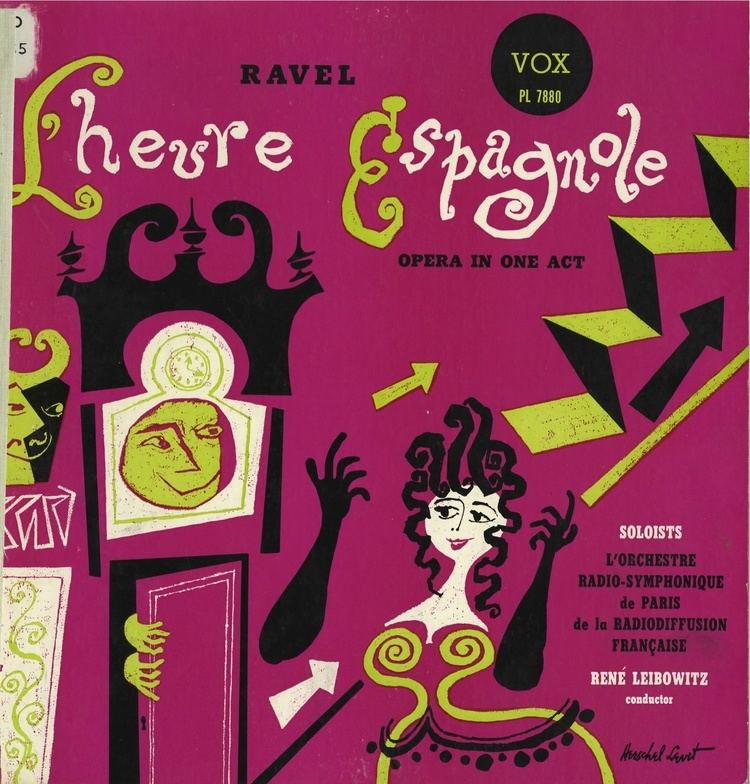Written 1909 Language French | First performance 19 May 1911 Librettist Maurice Étienne Legrand | |
 | ||
Similar L'enfant et les sortilèges, Daphnis et Chloé, Pelléas et Mélisande, Gianni Schicchi, Les mamelles de Tirésias | ||
L'heure espagnole is a one-act opera, described as a comédie musicale, with music by Maurice Ravel to a French libretto by Franc-Nohain, based on his play ('comédie-bouffe') of the same name first performed at the Théâtre de l'Odéon on 28 October 1904. The title can be translated literally as "The Spanish Hour", but the word "heure" more importantly means "time" – "Spanish Time", with the connotation "How They Keep Time in Spain". Ravel had been at work on the music as early as 1907.
Contents
- L heure espagnole sophie koch paris 2004
- Performance history
- Musical background
- Synopsis
- Recordings
- References
L heure espagnole sophie koch paris 2004
Performance history
Ravel was closely involved in every aspect of the production as it was prepared for its premiere at the Opéra-Comique in Paris. The opera was first performed at the Opéra-Comique on 19 May 1911, in a double-bill with Thérèse by Jules Massenet; after the initial nine performances it was not revived. The Paris Opéra presented it on 5 December 1921 with Fanny Heldy as Concepción, and it enjoyed more success. The opera returned to the Opéra-Comique in 1945 where it continued in the repertoire. Outside France, L’heure espagnole was first seen at Covent Garden in 1919, Chicago and New York in 1920, Brussels in 1921, followed by Basel and Rotterdam (1923), Prague (1924), Hamburg, Stockholm (1925), reaching Buenos Aires in 1932 and Cairo in 1934. The opera was performed for the first time in Canada at the 1961 Montreal Festivals.
Musical background
In relation to Ravel's vocal writing in the opera, Roland-Manuel wrote "The language of the music is linked up as naturally as possible with the music of the language”. In an interview published two days before the premiere, Ravel explained his approach to his new opera. "I have written an opéra-bouffe. Apart from [Gonzalve] who sings sérénades and cavatines with deliberately exaggerated melodies, the other rôles will give, I think, the impression of being spoken." Ravel also cited Mussorgsky's The Marriage for the effect he was aiming to achieve in the word setting, and underlined the Spanish elements of the score in his use of jotas, habaneras and malagueñas. Kobbé commented that from "the delightful clock noises of the opening to the Habanera quintet of the end, L'Heure Espagnole is full of charming music", while Grove notes that the opera is one of a group of Spanish influenced works that span Ravel’s career and that in it he employed "a virtuouso use of the modern orchestra".
Synopsis
Time: 18th centuryPlace: The workshop of the clockmaker Torquemada in Toledo, Spain.The opera takes place in 21 scenes, with an introduction.
Torquemada is at work in his shop when the muleteer Ramiro stops by to have his watch fixed, so that he can fulfill his duties at collecting the town's post. It is Thursday, the day that Torquemada goes out to tend the municipal clocks, so Ramiro must wait. Torquemada's wife, Concepción, enters to complain that her husband hasn't yet moved a clock into her bedroom. After Torquemada has left, she takes advantage of his absence to plan assignations with gentleman friends. However, the presence of Ramiro is initially a hindrance. So she asks him to move a grandfather clock to her bedroom, which he agrees to do.
Meanwhile, she waits for Gonzalve, a poet. He arrives, and is inspired to poetry, but not to lovemaking, where Concepción would prefer the latter. When Ramiro is about to return, she sends him back saying that she chose the wrong clock. She then has the idea of having Gonzalve hide in one clock so that Ramiro can carry him upstairs. After Gonzalve is concealed, Don Iñigo, a banker and another of Concepción's gentleman friends, arrives. When Ramiro returns, she persuades him to carry up the clock with Gonzalve concealed in it, and she accompanies him.
On his own, Don Iñigo conceals himself in another clock. Ramiro enters, asked to watch the shop, and musing on how little he understands of women. Concepción then summons him back upstairs, saying that the clock's hands are running backwards. She and Don Iñigo try to communicate, but Ramiro arrives back with the other clock. Don Iñigo has hidden himself again, and Ramiro now carries up the clock with Don Iñigo upstairs.
With Gonzalve now downstairs, Concepción tries to turn him away from poetry towards her, but Gonzalve is too absorbed to follow her lead. Ramiro returns, and Gonzalve must conceal himself again. He offers to take the second clock up again. Impressed by how easily Ramiro carries the clocks (and their load) upstairs, Concepción begins to be physically attracted to him.
With Gonzalve and Don Iñigo now each stuck in clocks, Torquemada returns from his municipal duties. Both Gonzalve and Don Inigo eventually escape their respective clock enclosures, the latter with more difficulty. To save face, they each have to purchase a clock. Concepción is now left without a clock, but she muses that she can wait for the muleteer to appear regularly with his watch repaired. The opera ends with a quintet finale, as the singers step out of character to intone the moral of the tale, paraphrasing Boccaccio:
